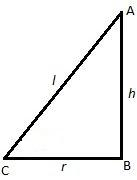
Answer
497.4k+ views
First assume that radius of cylinder $=r$ and height of the cylinder $=h$ , then in the right circular cone, assume its slant height $=l$. Calculate $l$ by using Pythagoras Theorem. Then calculate, total Surface Area of a solid cylinder $=2\pi rh+2\pi {{r}^{2}}$, Lateral Surface Area of a cylinder $=2\pi rh$, Total Surface Area of a solid cone $=\pi rl+\pi {{r}^{2}}$, Lateral Surface Area of a cone $=\pi rl$.
Complete step-by-step answer:
Radius of cylinder be $r=\dfrac{d}{2}=\dfrac{12}{2}=6\text{ cm}$ where $d=$ diameter of the cylinder.
And, the height of the cylinder is $h=7\text{ cm}$.
Now, we have given that the radii and heights of both the cone and cylinder are the same.
When we remove the portion of cone from the solid cylinder we have to imagine how the remaining portion will look. We observe that the lateral surface area of the cylinder is visible and one of the circular bases is also remaining. Now, the lateral surface of the cone is also visible while one of the base circles of the cylinder is cut out. Therefore, the required total surface area of the remaining solid is given by the sum of lateral surface area of cylinder, lateral surface area of cone and the area of the remaining circular base of cylinder.


$\text{Required area = }2\pi rh+\pi rl+\pi {{r}^{2}}.............................(i)$
Where, \[l=\] slant height of cone.
In the right circular cone, we use Pythagoras theorem to determine slant height \[l\].
Pythagoras theorem states that in a right angled triangle ABC whose hypotenuse is \[c\]and other two sides are \[a\] and \[b\] then ${{a}^{2}}+{{b}^{2}}={{c}^{2}}$.
Therefore considering \[c=l\], \[a=h\] and $b=r$ we get;
$\begin{align}
& {{l}^{2}}={{h}^{2}}+{{r}^{2}} \\
& \therefore l=\sqrt{{{h}^{2}}+{{r}^{2}}} \\
\end{align}$
Now substituting values of $l,h,r$ in equation \[\left( i \right)\], we get
\[\begin{align}
& \text{Required Area = }\left( \text{2}\times \dfrac{22}{7}\times 6\times 7 \right)+\left( \dfrac{22}{7}\times 6\times \sqrt{{{7}^{2}}+{{6}^{2}}} \right)+\left( \dfrac{22}{7}\times {{6}^{2}} \right) \\
& \text{ = 264+173}\text{.85+113}\text{.14} \\
& \text{ }\approx 551\text{ c}{{\text{m}}^{2}} \\
\end{align}\]
Note: One may get confused in imagining the required figure, therefore it is better to draw the figure somewhere and then solve the question. One should memorize the formulas of areas of different shapes to solve the problem in time.
Complete step-by-step answer:
Radius of cylinder be $r=\dfrac{d}{2}=\dfrac{12}{2}=6\text{ cm}$ where $d=$ diameter of the cylinder.
And, the height of the cylinder is $h=7\text{ cm}$.
Now, we have given that the radii and heights of both the cone and cylinder are the same.
When we remove the portion of cone from the solid cylinder we have to imagine how the remaining portion will look. We observe that the lateral surface area of the cylinder is visible and one of the circular bases is also remaining. Now, the lateral surface of the cone is also visible while one of the base circles of the cylinder is cut out. Therefore, the required total surface area of the remaining solid is given by the sum of lateral surface area of cylinder, lateral surface area of cone and the area of the remaining circular base of cylinder.


$\text{Required area = }2\pi rh+\pi rl+\pi {{r}^{2}}.............................(i)$
Where, \[l=\] slant height of cone.
In the right circular cone, we use Pythagoras theorem to determine slant height \[l\].
Pythagoras theorem states that in a right angled triangle ABC whose hypotenuse is \[c\]and other two sides are \[a\] and \[b\] then ${{a}^{2}}+{{b}^{2}}={{c}^{2}}$.
Therefore considering \[c=l\], \[a=h\] and $b=r$ we get;
$\begin{align}
& {{l}^{2}}={{h}^{2}}+{{r}^{2}} \\
& \therefore l=\sqrt{{{h}^{2}}+{{r}^{2}}} \\
\end{align}$
Now substituting values of $l,h,r$ in equation \[\left( i \right)\], we get
\[\begin{align}
& \text{Required Area = }\left( \text{2}\times \dfrac{22}{7}\times 6\times 7 \right)+\left( \dfrac{22}{7}\times 6\times \sqrt{{{7}^{2}}+{{6}^{2}}} \right)+\left( \dfrac{22}{7}\times {{6}^{2}} \right) \\
& \text{ = 264+173}\text{.85+113}\text{.14} \\
& \text{ }\approx 551\text{ c}{{\text{m}}^{2}} \\
\end{align}\]
Note: One may get confused in imagining the required figure, therefore it is better to draw the figure somewhere and then solve the question. One should memorize the formulas of areas of different shapes to solve the problem in time.
Recently Updated Pages
Fill in the blanks with suitable prepositions Break class 10 english CBSE

Fill in the blanks with suitable articles Tribune is class 10 english CBSE

Rearrange the following words and phrases to form a class 10 english CBSE

Select the opposite of the given word Permit aGive class 10 english CBSE

Fill in the blank with the most appropriate option class 10 english CBSE

Some places have oneline notices Which option is a class 10 english CBSE

Trending doubts
Fill the blanks with the suitable prepositions 1 The class 9 english CBSE

How do you graph the function fx 4x class 9 maths CBSE

Which are the Top 10 Largest Countries of the World?

What is the definite integral of zero a constant b class 12 maths CBSE

The Equation xxx + 2 is Satisfied when x is Equal to Class 10 Maths

Differentiate between homogeneous and heterogeneous class 12 chemistry CBSE

Define the term system surroundings open system closed class 11 chemistry CBSE

Full Form of IASDMIPSIFSIRSPOLICE class 7 social science CBSE

Change the following sentences into negative and interrogative class 10 english CBSE




